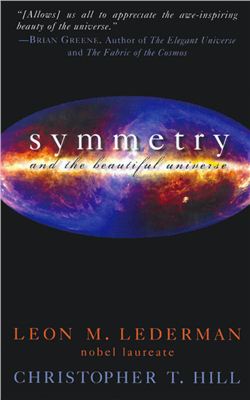Prometheus Books, 2004, 363 pages
When scientists peer through a telescope at the distant stars in outer space or use a particle-accelerator to analyse the smallest components of matter, they discover that the same laws of physics gove the whole universe at all times and all places.Physicists call the eteal, ubiquitous constancy of the laws of physics symmetry. Symmetry is the basic underlying principle that defines the laws of nature and hence controls the universe. This all-important insight is one of the great conceptual breakthroughs in mode physics and is the basis of contemporary efforts to discover a grand unified theory to explain all the laws of physics. Nobel Laureate Leon M Lederman and physicist Christopher T Hill explain the supremely elegant concept of symmetry and all its profound ramifications to life on Earth and the universe at large in this eloquent, accessible popular science book. They not only clearly describe concepts normally reserved only for physicists and mathematicians, but they also instil an appreciation for the profound beauty of the universe's inherent design.Central to the story of symmetry is an obscure, unpretentious, but extremely gifted German mathematician named Emmy Noether. Though still little known to the world, she impressed no less a scientist than Albert Einstein, who praised her 'penetrating mathematical thinking'. In some of her earliest work she proved that the law of the conservation of energy was connected to the idea of symmetry and thus laid the mathematical groundwork for what may be the most important concept of mode physics. Lederman and Hill reveal concepts about the universe, based on Noether's work, that are largely unknown to the public and have wide-reaching implications in connection with the Big Bang, Einstein's theory of relativity, quantum mechanics, and many other areas of physics. Through ingenious analogies and illustrations, they bring these astounding notions to life. This book will open your eyes to a universe you never knew existed.
When scientists peer through a telescope at the distant stars in outer space or use a particle-accelerator to analyse the smallest components of matter, they discover that the same laws of physics gove the whole universe at all times and all places.Physicists call the eteal, ubiquitous constancy of the laws of physics symmetry. Symmetry is the basic underlying principle that defines the laws of nature and hence controls the universe. This all-important insight is one of the great conceptual breakthroughs in mode physics and is the basis of contemporary efforts to discover a grand unified theory to explain all the laws of physics. Nobel Laureate Leon M Lederman and physicist Christopher T Hill explain the supremely elegant concept of symmetry and all its profound ramifications to life on Earth and the universe at large in this eloquent, accessible popular science book. They not only clearly describe concepts normally reserved only for physicists and mathematicians, but they also instil an appreciation for the profound beauty of the universe's inherent design.Central to the story of symmetry is an obscure, unpretentious, but extremely gifted German mathematician named Emmy Noether. Though still little known to the world, she impressed no less a scientist than Albert Einstein, who praised her 'penetrating mathematical thinking'. In some of her earliest work she proved that the law of the conservation of energy was connected to the idea of symmetry and thus laid the mathematical groundwork for what may be the most important concept of mode physics. Lederman and Hill reveal concepts about the universe, based on Noether's work, that are largely unknown to the public and have wide-reaching implications in connection with the Big Bang, Einstein's theory of relativity, quantum mechanics, and many other areas of physics. Through ingenious analogies and illustrations, they bring these astounding notions to life. This book will open your eyes to a universe you never knew existed.

